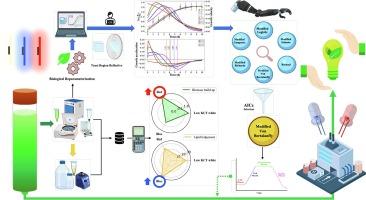Process engineering analysis of LED-driven microalgal growth and lipid lodgement dynamics through kinetic modelling and illumination energetic approach
IF 9.9
1区 工程技术
Q1 ENERGY & FUELS
引用次数: 0
Abstract
Photosynthetic world of microalgae has been briefly explored for possible solution(s) in nexus of energy, environmental and healthcare challenges by zeroing in on biomass build-up and lipid lodgement as responses of the conducted study. Illumination engineering was employed to measure impacts of variations in terms of photosynthetic photon flux density (PPFD) and photoperiod of low kelvin colour temperature (KCT) white, blue, and red light emitting diodes (LEDs) on Chlorella vulgaris. Cultivation was tracked through responses in terms of dry cell weight (DCW) for biomass build-up, and as %DCW for lipid lodgement. Two-way analysis of variance (ANOVA) with interaction (type III) and effect size (η2) metric helped in understanding their statistical and practical significance respectively. The best biomass build-up (1.41 ± 0.03 g/L) was observed at 100 PPFD and 24:0h photoperiod under red spectrum and highest lipid lodgement (34.36 ± 1.45 %DCW) was obtained at 150 PPFD and 8:16 h photoperiod under blue spectrum. To bridge the lacuna in growth kinetics literature, a novel reparameterization of Von Bertalanffy model was presented. Kinetic parameters for the best possible responses under each LED setting were fitted into the model with trust region reflective (TRF) algorithm. Akaike information criteria corrected (AICc) revealed the proposed “Modified Von Bertalanffy model” to be the best out of five models (Modified Von Bertalanffy, Modified Logistic, Modified Gompertz, Modified Richards and Modified Baranyi). The duration of exponential phase was determined from the rate of change of maximum specific growth rate (). The values and the duration of exponential phase were correlated with the responses, hinting at future directions in understanding the kinetic studies of growth induced (during exponential phase) and stress induced (post exponential phase) cultivation. Based on the lux requirements for best possible response, the projected energy savings of various models were compared using company data sheets from Broadcom, Seoul Semiconductor, and Cree.

通过动力学建模和光照能量法对 LED 驱动的微藻生长和脂质沉积动力学进行过程工程分析
本研究以生物量积累和脂质沉积为切入点,简要探讨了微藻类光合作用在应对能源、环境和医疗保健挑战方面可能的解决方案。照明工程被用来测量光合光通量密度(PPFD)和低开尔文色温(KCT)白光、蓝光和红光发光二极管(LED)的光周期变化对普通小球藻的影响。通过干细胞重量(DCW)和脂质沉积率(%DCW)来跟踪培养过程中的生物量积累情况。带有交互作用(III 型)和效应大小(η2)指标的双向方差分析(ANOVA)分别有助于了解其统计意义和实际意义。在红色光谱下,100 PPFD 和 24:0 小时光周期下的生物量积累(1.41 ± 0.03 g/L)最好;在蓝色光谱下,150 PPFD 和 8:16 小时光周期下的脂质沉积(34.36 ± 1.45 %DCW)最高。为了弥补生长动力学文献的空白,提出了一种新的冯-贝塔朗菲模型重参数化方法。利用信任区域反射(TRF)算法将每种 LED 设置下最佳反应的动力学参数拟合到模型中。经 Akaike 信息标准校正(AICc)后发现,所提出的 "修正的冯-贝塔朗菲模型 "是五个模型(修正的冯-贝塔朗菲模型、修正的 Logistic 模型、修正的 Gompertz 模型、修正的 Richards 模型和修正的 Baranyi 模型)中最好的。指数阶段的持续时间是根据最大比增长率(μm)的变化率确定的。μm值和指数期持续时间与反应相关,这为了解生长诱导(指数期)和压力诱导(指数期后)培养的动力学研究指明了未来的方向。根据最佳响应的勒克斯要求,使用 Broadcom、Seoul Semiconductor 和 Cree 公司的数据表对各种型号的预计节能效果进行了比较。
本文章由计算机程序翻译,如有差异,请以英文原文为准。
求助全文
约1分钟内获得全文
求助全文
来源期刊

Energy Conversion and Management
工程技术-力学
CiteScore
19.00
自引率
11.50%
发文量
1304
审稿时长
17 days
期刊介绍:
The journal Energy Conversion and Management provides a forum for publishing original contributions and comprehensive technical review articles of interdisciplinary and original research on all important energy topics.
The topics considered include energy generation, utilization, conversion, storage, transmission, conservation, management and sustainability. These topics typically involve various types of energy such as mechanical, thermal, nuclear, chemical, electromagnetic, magnetic and electric. These energy types cover all known energy resources, including renewable resources (e.g., solar, bio, hydro, wind, geothermal and ocean energy), fossil fuels and nuclear resources.
 求助内容:
求助内容: 应助结果提醒方式:
应助结果提醒方式:


